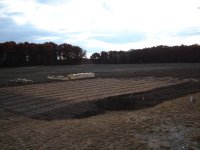woodlot
Gold Member
Hope you guys can help. I've got a delemma. This weekend I'll be running a 200amp service to a new pole barn. I was going to run it from my homes main panel but my plans have changed. I'm now going to run it from the main disconnect panel that sits directly under the meter. The meter and main disconnect sit in the yard, about 150ft from the house. The main disconnect is a "through lug" type so it will serve the homes main panel and the main panel in the barn. The neutral is bonded to the grounding electrodes within the main disconnect panel. There is currently 3-wires serving the house and there will be 3 wires serving the barn (no bonding wire to either structure). There are no other metal paths between the pedestal and the structures so the 3-wire system should be fine. HOWEVER, and my DELEMMA, is this: there will be RG-6 and cat5e wire running between the house and the barn. Is that a code violation or a safty issue???? As always thanks for your help!
attached is a pic of the building site. I had a dozer come in and build the pad, no fill was used. My soil is primarly sand so I saved a bundle. It will take the framing crew 2.5 days to build.
attached is a pic of the building site. I had a dozer come in and build the pad, no fill was used. My soil is primarly sand so I saved a bundle. It will take the framing crew 2.5 days to build.
